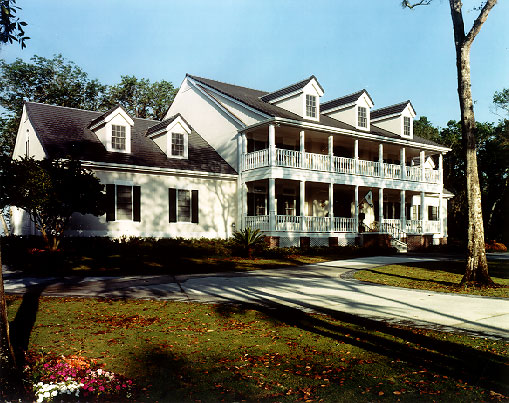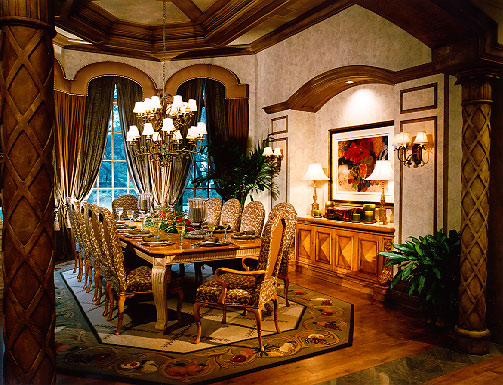"21st-Century Style"
Unique Homes magazine, January 2000
Excerpts from the article by Linda Kast

It's true that at one time the 21st century loomed like Big Brother on the horizon, looking a little sterile, much too clinical, and none too hospitable. But now that it's finally here, the new millennium seems far less daunting and much more personalized.
Contrary to any far-fetched notions, housing designs for the next century will not spin out of control into space stations floating in the clouds, awaiting the home owner's arrival on a jetson-style ship. Rather, communities of the past will provide us with guidelines toward constructing the future -- re-establishing the human scale of our neighborhoods. At least that is what architect Tom Price, AIA, gauges from the clientele he designs for in Orlando, Fla. Home owners used to want their homes to look bigger, more impressive, he says. Now they want their 10,000-square-foot home to feel smaller and more comfortable.
Architecture critic Beth Dunlop also notes an increasing desire among home owners for human connection. Because of technological advances, individuals are increasingly isolated at their computers, often for days at a time if they work from their homes. "We contact each other through the Internet all day long," she says. "But it's contact without touch. People long for a sense of community because that's all they've got left."
The loss of belonging has spurred a renewed thrust toward creating specialized communities. In their book, "Next: Trends for the Near Future," Ira Matathia and Marian Salzman cite the work of new urbanists and the revival of a village-style approach to community planning, where parks, walking and bike trails, and narrower streets abound, as one answer to isolation and changing lifestyles.
Home buyers today also take comfort with architecture of the past, drawing inspiration from tried-and-true designs. Old World reminders and signposts are powerful icons, says Dunlop, adding that people look for certain styles of homes that provide a combination of experience and memory. "We are moving toward ever more authenticity," she says. "It's not just Colonial style houses that people want, but homes with [real roots]."
Dunlop gives an example of a nostalgic connection. "More people want to live in the kind of place where their grandparents lived," she says, "[such as] places like Nantucket or Charleston." As a result, Dunlop predicts, an increasing amount of attention will be paid to great houses in great neighborhoods in the areas of renovation and reuse, particularly in places infused by an established neighborhood feeling and architectural beauty, including Chicago, New York and Boston.
Traditional... With an Edge
While traditional style seems to be winning the race for tomorrow's housing designs, floor plans will go a step further and incorporate modern ideas geared for changing lifestyles. Interiors will have spaces that are more flexible. As interior designer and American Society of Interior Designers past president Rosalyn Cama, FASID, puts it, "A standard center-hall colonial that's blown up to give buyers more space doesn't answer their real needs. What people really value has less to do with image and more to do with behavior." Cama says that behavior translates to comfort and convenience: interiors that include more storage, better entertaining spaces and more networked computers throughout the house.
Modern, but not futuristic, kitchens will move beyond the conventional (with simply a refrigerator, stove and sink), without falling prey to labels of sterile, cold and unused. Instead, the kitchen will continue in its role as gathering spot, if not for everyday cooking, then for the occasional mealtime celebration in which everyone partakes. Multiple cooks favor multiple cook stations, and new innovations such as refrigerated drawers and dishwasher drawers (instead of the cumbersome units) placed strategically throughout the kitchen, and dual-fuel cooktops and ovens will give rise to kitchen designs centered around fun, activity and entertaining. Several of Price's clients are even asking for a kitchen-and-a-half plan, one kitchen designed for intimate family use and an adjoining room available for catering large-scale events.
Structural advances, such as vaulted ceilings, have prompted the need for a balanced approach between intimate zones and soaring spaces. Based on open floor plans in which rooms flow into each other, home owners will insist on finishes made from the best wood, the best stone and the best possible designs. "Because you see into each room," Dunlop notes, "the craftsmanship must carry room to room."
Furthermore, Louis Postel, editor-in-chief of Design Times magazine, notes that the future of interiors will mark "a return to understated luxury, a more personal, finely nuanced, almost sensual style" captured within the walls of elegant homes. Interiors fraught with too obvious a contrast between expensive materials, such as granite paired with tropical woods, will disappear.
The dining room will take its rightful place of redemption in homes of the future. Previously considered a shrinking commodity, more architects and designers see dining as a therapeutic part of family togetherness and a celebration of food, glorious food. Expect to see a greater emphasis on comfort and the creation of a peaceful destination conducive to conversation, mealtimes and family connectivity.
Back to Publications main page
|